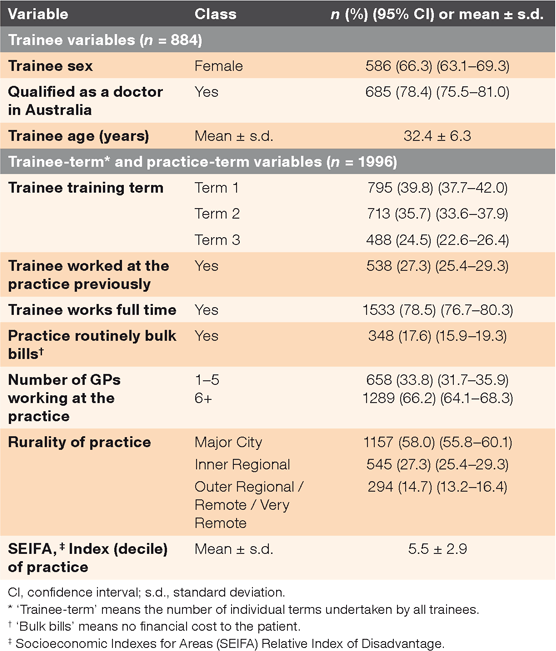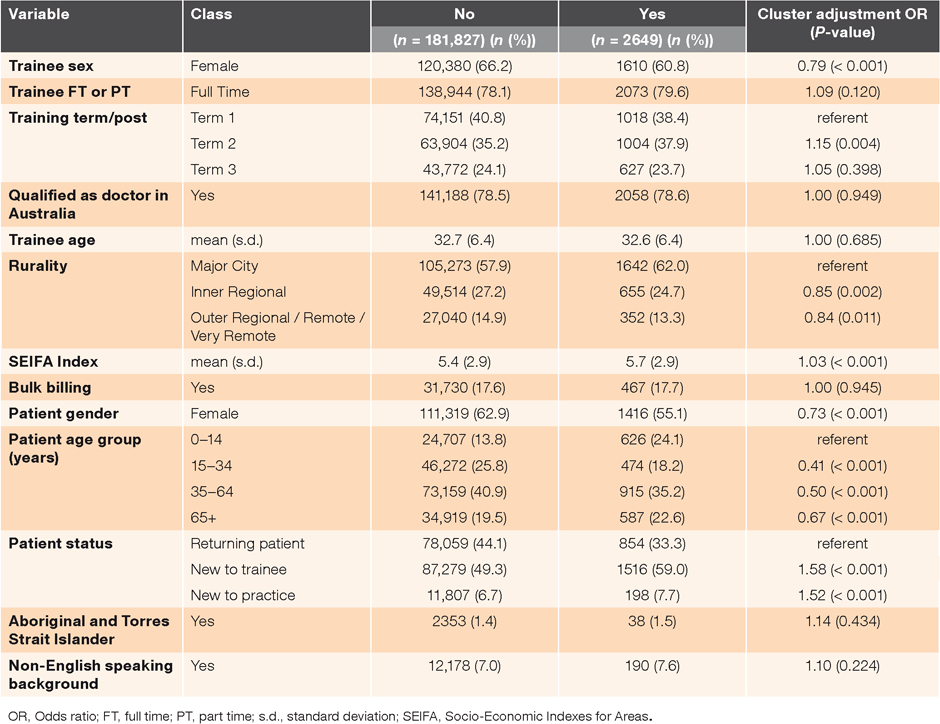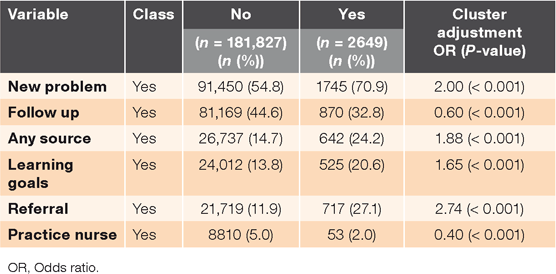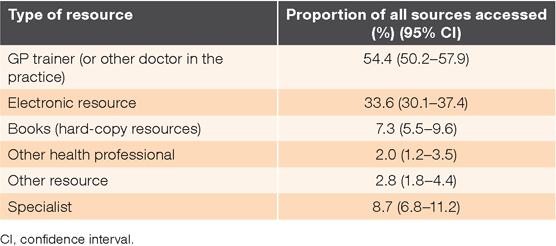Australian general practice trainees’ exposure to ophthalmic problems and implications for training: a cross-sectional analysis
Simon Morgan 1 , Amanda Tapley 2 , Kim M Henderson 2 , Neil A Spike 3 , Lawrie A McArthur 4 , Rebecca Stewart 5 , Andrew R Davey 6 , Anthony Dunlop 7 , Mieke L van Driel 8 , Parker J Magin 2 61 Elermore Vale General Practice, Newcastle, New South Wales, Australia
2 GP Synergy, Mayfield, New South Wales, Australia
3 Eastern Victoria General Practice Training, Melbourne, Victoria, Australia
4 University of Adelaide, Adelaide, South Australia, Australia
5 Tropical Medicine Training, Townsville, Queensland, Australia
6 University of Newcastle, Discipline of General Practice, Callaghan, New South Wales, Australia
7 Care Foresight P/L, Newcastle, New South Wales, Australia
8 University of Queensland, Academic Discipline of General Practice, Brisbane, Queensland, Australia
Correspondence to: Simon Morgan, Elermore Vale General Practice, Elermore Vale, New South Wales 2287, Australia. Email: lochswilly@gmail.com
Journal of Primary Health Care 8(4) 295-302 https://doi.org/10.1071/HC16024
Published: 21 December 2016
Journal Compilation © Royal New Zealand College of General Practitioners 2016.
This is an open access article licensed under a Creative Commons Attribution-NonCommercial-NoDerivatives 4.0 International License.
Abstract
INTRODUCTION: Eye conditions are common presentations in Australian general practice, with the potential for serious sequelae. Pre-vocational ophthalmology training for General Practitioner (GP) trainees is limited.
AIM: To describe the rate, nature and associations of ophthalmic problems managed by Australian GP trainees, and derive implications for education and training.
METHODS: Cross-sectional analysis from an ongoing cohort study of GP trainees’ clinical consultations. Trainees recorded demographic, clinical and educational details of consecutive patient consultations. Descriptive analyses report trainee, patient and practice demographics. Proportions of all problems managed in these consultations that were ophthalmology-related were calculated with 95% confidence intervals (CI). Associations were tested using simple logistic regression within the generalised estimating equations (GEE) framework.
RESULTS: In total, 884 trainees returned data on 184,476 individual problems or diagnoses from 118,541 encounters. There were 2649 ophthalmology-related problems, equating to 1.4% (95% CI: 1.38–1.49) of all problems managed. The most common eye presentations were conjunctivitis (32.5% of total problems), eyelid problems (14.9%), foreign body (5.3%) and dry eye (4.7%). Statistically significant associations were male trainee; male patient and patient aged 14 years or under; the problem being new and the patient being new to both trainee and practice; urban and of higher socioeconomic status practice location; the practice nurse not being involved; planned follow up not arranged; referral made; in-consultation information sought; and learning goals generated.
DISCUSSION: Trainees have comparable ophthalmology exposure to established GPs. However, associations with referral and information-seeking suggest GP trainees find ophthalmic problems challenging, reinforcing the critical importance of appropriate training.
KEYWORDS: General practice; ophthalmology; eye disease; education; medical; graduate
| WHAT GAP THIS FILLS |
| What is already known: Eye conditions are common general practice presentations in Australia, and range in nature from minor problems to vision-threatening emergencies. Ophthalmology is a challenging area of clinical general practice and inadequacies of ophthalmology training for medical students and junior doctors have previously been described. |
| What this study adds: It has been demonstrated that GP trainees have comparable ophthalmology exposure to established GPs, and study findings suggest that trainees find ophthalmology-related problems challenging. This reinforces the importance of specific training in ophthalmology for pre-vocational doctors and GP trainees. |
Introduction
Eye conditions are common in Australian general practice, seen at a rate of 2.2 per 100 encounters and comprising 1.4% of all problems managed.1 They range in nature from minor problems to vision-threatening emergencies. Eye problems are the fifth most common reason for medical specialist referral in Australia, making up 7.3% of such referrals.1
Ophthalmology is a challenging area of clinical general practice, and general practitioners (GPs) need up-to-date knowledge and skills. Inadequacies of ophthalmology training for medical students and junior doctors have been identified in Australia and internationally.2–4 Unlike many other medical specialties, junior doctor hospital posts in ophthalmology are uncommon, so general practice trainees often have limited experience of, and training in, ophthalmology before commencing community-based training.
The Australian General Practice Training (AGPT) programme involves a minimum of three 6-month terms of experiential learning in general practice. Registrars (trainees) can seek advice from GP supervisors (trainers) in ‘apprenticeship-like’ relationships, but otherwise they see unreferred patients and practice independently.
For ophthalmology, as with other clinical areas, consulting with patients provides GP trainees with opportunities to apply knowledge and skills acquired in structured educational sessions and independent study. Without understanding the clinical exposure of GP trainees to ophthalmic problems, we cannot structure best practice education and training. The scope of ophthalmic problems managed by GP trainees has not previously been described in the literature.
We aimed to explore the rate and nature of GP trainee exposure to ophthalmic problems, as well as the clinical and educational associations of this exposure, in order to better understand the implications for education and training.
Methods
This was a cross-sectional analysis of GP trainee consultations as part of the Registrar Clinical Encounters in Training (ReCEnT) study. The study methodology has been described in detail elsewhere.5 Briefly, ReCEnT is an ongoing cohort study of the in-practice clinical experiences of GP trainees. It is undertaken in five of Australia’s 17 general practice regional training providers and encompasses urban, rural and remote practices in five of Australia’s six states.
Participating trainee characteristics and characteristics of their practice are recorded. In each of their 6-month training terms in general practice, trainees record the details of 60 consecutive patient encounters (consultations), representing approximately 1 week of consultations. Data collection is conducted around the mid-point of each training term and employs a standardised paper-based encounter form for each consultation. As data collection is designed to reflect a ‘normal’ week of general practice, consultations in a specialised clinic, for example, vaccination clinic or cervical smear clinic, are excluded. Only office-based consultations (not home visits or nursing home visits) are recorded.
Written informed consent is obtained for trainees’ de-identified data to be used for research purposes. Ethics approval for this study was obtained from the Human Research Ethics Committee of the University of Newcastle, NSW, Australia (approval number: H-2009–0323).
Statistical analysis
Analysis was performed on 10 rounds of data from 2010 to 2014. Individual regional training providers contributed 2–10 rounds of data, depending on their date of study commencement.
Descriptive analyses were used to report trainee, patient and practice demographics.
Proportions of ophthalmic problems were calculated with 95% confidence intervals (95% CIs). Ophthalmic problems were compared with all other problems. The most common eye conditions seen, procedures performed, and referrals made by trainees were also assessed with descriptive statistics using a categorisation constructed by the research team.
Associations of trainee, patient and practice factors with a problem being ophthalmic were tested using simple logistic regression within the generalised estimating equations (GEE) framework to account for the repeated-measures on trainees.
All analyses were conducted at the level of individual problem rather than consultation level. Analyses were programmed using STATA 13.1 (StataCorp LP, College Station, TX, USA). P-values < 0.05 were considered significant.
Outcome variable
The primary outcome variable in the regression analysis was whether an ophthalmic problem was managed by the trainee. In ReCEnT, a problem is defined as ‘the single most likely provisional diagnosis’. Trainees are asked to record at least one and up to four problems per patient encounter. Only problems actually dealt with at the encounter are recorded. Problems are coded according to the International Classification of Primary Care, second edition classification system (ICPC-2 plus).6 For the analysis of ophthalmic problems, all ICPC-2 codes coded ‘eye’ (F) were included.
Independent variables
Independent variables related to trainee, patient, practice, consultation and educational factors.
Trainee factors were age, sex, training term, place of medical qualification (Australia or international) and full- or part-time work status.
Patient factors were age, sex, Aboriginal and Torres Strait Islander status, non-English speaking background, new patient to the practice, and new patient to the trainee.
Practice factors were rurality, practice size (number of full-time equivalent GPs), socioeconomic status, and if the practice routinely bulk-bills (ie there is no financial cost to patients for consultations). Practice postcode was used to define the Australian Standard Geographical Classification-Remoteness Area classification (the degree of rurality) of the practice location,7 and to define the practice location’s Socio-Economic Indexes for Areas (socioeconomic status).8
Consultation factors included practice nurse involvement, referrals made and medications prescribed.
Educational factors included obtaining in-consultation information or advice, and generation of learning goals by the trainee for subsequent attention.
Results
Participants
A total of 884 trainees contributed data to the analysis. The response rate was 95.3%. Overall, 66.3% (95% CI: 63.1–69.3) of trainees were female, and their mean age was 32.4 years (standard deviation (s.d.): 6.3). Trainees who completed their primary medical degree in Australia comprised 78.4% (95% CI: 75.5–81.0) of trainees, and 78.5% (95% CI: 76.7–80.3) of all trainees worked 2.5 days per week or more. Table 1 displays the characteristics of participating trainees, trainee-terms and practices.

|
Ophthalmic problems
Overall, trainees returned data on 184,476 individual problems from 118,541 encounters. There were 2649 ophthalmic problems managed, accounting for 1.4% (95% CI: 1.38–1.49) of all problems managed. This equates to a rate of 2.2 (95% CI: 2.15–2.32) ophthalmic problems per 100 encounters.
Table 2 shows that the most common eye presentations were conjunctivitis (32.5% (95% CI: 30.7–34.3) of total ophthalmic problems), eyelid problems (14.9% (95% CI:13.5–16.3)), foreign body (5.3% (95% CI:4.5–6.2)) and dry eye (4.7% (95% CI: 3.9–5.6)). A procedure was performed in 3.7% (95% CI: 3.0–4.4) of ophthalmic problems; the most common procedure was removal of a corneal foreign body (32.7% (95% CI: 24.0–42.7) of procedures).

|
Table 3 presents the characteristics of trainees, patients, and practices for ophthalmic problems in comparison to all other problems. Table 4 presents the characteristics of consultations involving ophthalmic problems in comparison to all other problems.

|

|
Male trainees were significantly more likely to manage ophthalmic problems. Male patients and patients aged ≤ 14 years were significantly more likely to have eye problems managed. Patients with ophthalmic problems were significantly more likely to be new to both trainee and practice, compared to patients with non-ophthalmic problems. The problem itself was also more likely to be new.
Ophthalmic problems were significantly more likely to be managed in urban practices and in practices located in areas of higher socioeconomic status. Practice nurses were significantly less frequently involved in the management of ophthalmic problems than other problems.
Ophthalmic problems were significantly less likely to lead to planned follow up, but led to a significantly greater rate (2.7-fold, P < 0.001) of referral to all agencies compared to non-ophthalmic problems (referral rate 27.1% (95% CI: 25.4–28.8)). Most of these referrals were to ophthalmologists (70.0% (95% CI: 66.5–73.3)) or optometrists (19.5% (95% CI: 16.7–22.6)), with 5.9% (95% CI: 4.4–7.9) referred directly to hospital. The most common problems referred to ophthalmologists were cataracts (11.1% of all ophthalmologist referrals), eyelid problems (9.3%) and glaucoma (8.1%). As a proportion of ophthalmology problems managed, 69.6% of cataracts and 48.1% of glaucoma problems were referred at the index consultation. Referrals to ophthalmologists are presented in Table 2. Of all hospital referrals, 39.5% were for a foreign body.
Trainees sought in-consultation information or advice for 24.2% (95% CI: 22.6–25.9) of ophthalmic problems. This was significantly more common (1.9-fold, P < 0.001) than for non-ophthalmic problems (14.7% (95% CI: 14.5–14.9)). For problems where in-consultation information was sought by trainees, 54.0% (95% CI: 50.2–57.9) of advice sources were trainers (or other doctors in the practice); 8.7% (95% CI: 6.8–11.2) were specialists, 33.6% (95% CI: 30.1–37.4) were electronic resources and 7.3% (95% CI: 5.5–9.6) were hard-copy resources. The most common resources accessed are listed in Table 5 (more than one source may be accessed per problem).

|
Trainees generated learning goals in 20.6% (95% CI: 19.1–22.2) of ophthalmic problems, significantly more frequently (1.6-fold) than for non-ophthalmic problems (13.8% (95% CI: 13.6–13.9)).
Discussion
This is the first published study of the prevalence, nature and associations of ophthalmic problems managed by GP trainees. We found that eye conditions were commonly seen by trainees overall and most eye problems managed were minor. We identified several significant associations with ophthalmic diagnoses.
Comparison with previous studies
The prevalence of ophthalmic problems in GP trainees’ practices was comparable with that of established Australian GPs (1.4% of problems and 2.2 per 100 encounters).1 This compares to a rate of 1.5 per 100 encounters in British general practice.9 A recent Dutch study found that the rate of managing ophthalmic problems was higher for trainees than for their GP trainers.10
Simple eye problems (conjunctivitis and eyelid problems) were the commonest presentations to GP trainees, comprising nearly half of all eye problems managed. The nature of eye problem presentations to trainees is similar to eye presentations to GPs in the UK.9 However, we could find no comparable data on the nature of the eye problems managed or rate of eye-related procedures by Australian GPs.
Patients with ophthalmic problems were most likely to be young (aged 0–14 years) and male. The younger age is consistent with the epidemiology of the eye diseases commonly seen by the GP trainees (most commonly conjunctivitis and eyelid problems). A male predominance of eye-related problems has been previously described.11
Ophthalmic problems were more likely than other problems to be new to trainees, and eye patients new to both trainee and practice. These findings are consistent with previous studies, which found that trainees see more new patients, new problems, acute minor problems and fewer older patients with chronic diseases.12,13 This is likely to reflect patient demographic differences (younger patients) and patient allocation practices.
GP trainees referred one-fifth (20.0%) of ophthalmic problems to ophthalmologists. This is considerably lower than established Australian GPs, who refer 31.1% of patients with ophthalmic problems.1 This may reflect a different case-mix of eye conditions between the groups, with trainees more likely to see simple eye infections. The most common problems for referral (cataract and glaucoma) were the same as for established GPs, with similar rates of referral for each condition.1 Foreign body has been previously described as the most common reason for referral to emergency departments, consistent with our findings for GP trainees.14 There is no comparable literature to compare the other associations of ophthalmic problems.
Limitations of this study include not having conducted multivariable analyses. We have, therefore, not accounted for potential confounding in the associations we have established. Our intention in this paper was confined to broadly ‘mapping the territory’ of GP trainee ophthalmic problems.
Strengths and limitations
Our findings are broadly generalisable to Australian general practice training overall, as the trainee participants had similar demographic characteristics (age, sex and international medical graduate status) to the national GP trainee cohort.15 As well, we conducted this study in five regional training providers across five Australian states. We had a very high response rate for a study of GPs.16
We coded our data using ICPC2-plus, thus enabling comparability with other Australian studies. ICPC2-plus is the international standard for classifying primary care data, and the validity of this system has previously been demonstrated.17
Implications for educational practice and policy
Our findings have implications for general practice training and ophthalmology practice, and more broadly, for the delivery of quality primary health care.
We found that ophthalmic problems comprise 1.4% of all problems managed by GP trainees, making it a common presentation – comparable in frequency to urinary tract infection and anxiety.13 Ophthalmic problems are potentially complicated, with substantial potential for patient harm; it has been found that acute eye problems are frequently misdiagnosed or mismanaged in Australian primary care.14 Furthermore, eye medicine is a core element of both the Royal Australian College of General Practitioners18 and the Australian College of Rural and Remote Medicine19 curricula. Despite this, ophthalmology teaching has been found to be incomplete in medical schools internationally, including in Australia.2,3,20,21 Compounding this, there is limited opportunity for ophthalmological training and experience for junior hospital doctors. It is therefore critical that GP trainees have adequate training in, and exposure to, a broad range of ophthalmic problems during vocational training.
Our results showed that relatively straightforward eye conditions, mainly conjunctivitis and eyelid problems, were very common, with presentations of more serious eye diseases relatively uncommon. As well, ophthalmic procedures were not commonly performed (at a rate of 0.053 per 100 total problems managed overall). Furthermore, our findings of trainees referring patients more often, seeking more in-consultation information and advice, and generating more learning goals, suggest that trainees find the diagnosis and management of eye conditions difficult. This relatively narrow clinical exposure, coupled with the inherent difficulty in managing such problems, underscores the need for comprehensive, formal, out-of-practice ophthalmology training in pre-vocational doctors, or GP trainee educational release activities, including procedural skills. It also suggests a need to focus on specific GP-trainer education in ophthalmology. A practical eye skills workshop has been associated with significant and sustained practice change in key areas of ocular assessment in general practice.22
Implications for further research
We have presented an overview of the ophthalmic encounters of general practice trainees. Particular aspects of trainee clinical practice demand individual-focused analyses, including the nature and specific sources of information accessed and referrals made to specialists. There is a need to evaluate the existing delivery of the ophthalmology curriculum at the postgraduate level in Australia. Future work should also include the actual preparedness of GP trainees in managing eye conditions; an assessment of trainer confidence and ability in the provision of support to trainees managing eye conditions; and an assessment of resources accessed by trainers and trainees. As well, developing, implementing and assessing an affordable model of combined clinical and online education in the field of ophthalmology for GP trainees would be a suitable area for further research.
FUNDING
The study was funded by the participating educational organisations: General Practice Training Valley to Coast, the Victorian Metropolitan Alliance, General Practice Training Tasmania, and Adelaide to Outback GP Training Programme. These organisations were funded by General Practice Education and Training, an Australian Commonwealth Government initiative.
COMPETING INTERESTS
None declared.
ACKNOWLEDGEMENTS
The authors would like to acknowledge the registrars, supervisors and practices involved in this study.
References
[1] Britt H, Miller GC, Henderson J, et al. General practice activity in Australia 2013–14. General Practice Series no. 36. Sydney: Sydney University Press; 2014.[2] Fan JC, Sherwin T, McGhee CN. Teaching of ophthalmology in undergraduate curricula: a survey of Australasian and Asian medical schools. Clin Experiment Ophthalmol 2007; 35 310–7.
| Teaching of ophthalmology in undergraduate curricula: a survey of Australasian and Asian medical schools.Crossref | GoogleScholarGoogle Scholar |
[3] Welch S, Eckstein M. Ophthalmology teaching in medical schools: a survey in the UK. Br J Ophthalmol 2011; 95 748–9.
| Ophthalmology teaching in medical schools: a survey in the UK.Crossref | GoogleScholarGoogle Scholar |
[4] Mottow-Lippa L. Ophthalmology in the medical school curriculum: reestablishing our value and effecting change. Ophthalmology 2009; 116 1235–6.
| Ophthalmology in the medical school curriculum: reestablishing our value and effecting change.Crossref | GoogleScholarGoogle Scholar |
[5] Morgan S, Magin PJ, Henderson KM, et al Study protocol: the registrar clinical encounters in training (ReCEnT) study. BMC Fam Pract 2012; 13 50
| Study protocol: the registrar clinical encounters in training (ReCEnT) study.Crossref | GoogleScholarGoogle Scholar |
[6] Lamberts H, Wood M. International classification of primary care. Oxford, UK: Oxford University Press; 1987.
[7] Australian Bureau of Statistics. 1216.0 - Australian Standard Geographical Classification (ASGC), July 2011. Canberra: Commonwealth of Australia; 2011. [Cited 2016 Mar 1]. Available from: www.abs.gov.au/AUSSTATS/abs@.nsf/DetailsPage/1216.0July%202011?OpenDocument
[8] Australian Bureau of Statistics. 2039.0 - Information paper: An introduction to Socio-economic Indexes for Areas (SEIFA), 2006. Canberra: Commonwealth of Australia; 2008. [Cited 2016 Mar 1]. Available from: www.abs.gov.au/ausstats/abs@.nsf/mf/2039.0/
[9] Sheldrick JH, Wilson AD, Vernon SA, Sheldrick CM. Management of ophthalmic disease in general practice. Br J Gen Pract 1993; 43 459–62.
| 1:STN:280:DyaK2c7itF2rsg%3D%3D&md5=9bbbfb1fb95515f5a582e483cef78e74CAS |
[10] De Jong J, Visser MR, Wieringa-de Waard M. Exploring differences in patient mix in a cohort of GP trainees and their trainers. BMJ Open 2011; 1 e000318
| Exploring differences in patient mix in a cohort of GP trainees and their trainers.Crossref | GoogleScholarGoogle Scholar |
[11] Kumar NL, Black D, McClellan K. Daytime presentations to a metropolitan ophthalmic emergency department. Clin Experiment Ophthalmol 2005; 33 586–92.
| Daytime presentations to a metropolitan ophthalmic emergency department.Crossref | GoogleScholarGoogle Scholar |
[12] de Jong J, Visser MR, Mohrs J, Wieringa-de Waard M. Opening the black box: the patient mix of GP trainees. Br J Gen Pract 2011; 61 e650–7.
| Opening the black box: the patient mix of GP trainees.Crossref | GoogleScholarGoogle Scholar |
[13] Morgan S, Henderson K, Tapley A, et al Problems managed by Australian general practice trainees: results from the ReCEnT (Registrar Clinical Encounters in Training) study. Educ Prim Care 2014; 25 140–8.
| Problems managed by Australian general practice trainees: results from the ReCEnT (Registrar Clinical Encounters in Training) study.Crossref | GoogleScholarGoogle Scholar |
[14] Statham MO, Sharma A, Pane AR. Misdiagnosis of acute eye diseases by primary health care providers: incidence and implications. Med J Aus.t 2008; 189 402–4.
[15] General Practice Education and Training Limited (GPET). Annual Report to 30 June 2014. Canberra: GPET; 2014. [Cited 2016 Mar 1]. Available from: www.gpet.com.au/About-Us/Policies-/Annual-Report
[16] Bonevski B, Magin P, Horton G, et al Response rates in GP surveys – trialling two recruitment strategies. Aust Fam Physician 2011; 40 427–30.
[17] Britt H, Meza RA, Del Mar C. Methodology of morbidity and treatment data collection in general practice in Australia: a comparison of two methods. Fam Pract 1996; 13 462–7.
| Methodology of morbidity and treatment data collection in general practice in Australia: a comparison of two methods.Crossref | GoogleScholarGoogle Scholar | 1:STN:280:DyaK2s%2FlvVWrtQ%3D%3D&md5=93baef5b4977f010314740b502126bdeCAS |
[18] Royal Australian College of General Practitioners (RACGP). The RACGP Curriculum for Australian General Practice 2011. South Melbourne (AU): RACGP; 2011. [Cited 2016 Mar 1]. Available from: http://curriculum.racgp.org.au/statements/eye-and-ear-medicine/
[19] Australian College of Rural and Remote Medicine (ACRRM). ACRRM Primary Curriculum – 4th edition. Brisbane (AU): ACRRM; 2013. [Cited 2016 Mar 1]. Available from: www.acrrm.org.au/primarycurriculum/default.htm
[20] Albert DM, Bartley GB. A proposal to improve ophthalmic education in medical schools. Ophthalmology 2014; 121 1157–9.
| A proposal to improve ophthalmic education in medical schools.Crossref | GoogleScholarGoogle Scholar |
[21] Shah M, Knoch D, Waxman E. The state of ophthalmology medical student education in the United States and Canada, 2012 through 2013. Ophthalmology 2014; 121 1160–3.
| The state of ophthalmology medical student education in the United States and Canada, 2012 through 2013.Crossref | GoogleScholarGoogle Scholar |
[22] Jackson C, De Jong I, Schuluter PJ. Changing clinician practice. The RACGP/RACO National GP Eye Skills Workshop. Aust Fam Physician 2002; 31 285–90.


